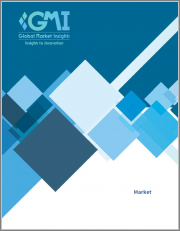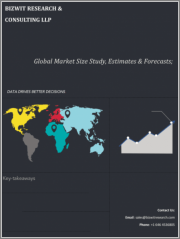
|
시장보고서
상품코드
1354307
나노테크놀러지 기반 약물전달 시장 : 기술별, 용도별, 세계 예측(2023-2032년)Nanotechnology-based Drug Delivery Market - By Technology (Nanocrystals, Nanoparticles, Liposomes, Micelles), Application (Neurology, Oncology, Cardiovascular/Physiology, Anti-inflammatory/Immunology, Anti-infective), Global Forecast, 2023 - 2032 |
||||||
세계의 나노테크놀러지 기반 약물전달 시장 규모는 2023-2032년에 12.5% 이상의 CAGR로 성장할 전망입니다.
약물의 용해도와 생체 이용률을 향상시키기 위해 나노입자를 기반으로 한 경구 약물전달 시스템을 연구하는 움직임이 활발해지면서 난수용성 약물의 전달에 혁명을 일으키고 있습니다. 최근 효과적이고 안전하며 상업적으로 실행 가능한 약물전달 플랫폼의 개발에 많은 관심이 집중되고 있습니다. 생명공학 및 나노 의료 분야에서 다재다능한 나노 캐리어 플랫폼의 발전도 시장 성장에 기여할 것으로 보입니다.
나노테크놀러지 기반 약물전달 산업은 기술, 용도, 지역별로 구분할 수 있습니다.
기술적인 측면에서 나노 결정 부문은 2023-2032년에 상당한 CAGR로 성장할 가능성이 있습니다. 이러한 성장은 특히 수용성이 낮은 화합물에서 다양한 약물의 용해도와 생체 이용률을 향상시키는 나노 결정의 잠재력이 높아졌기 때문입니다. 나노 결정은 또한 용해에 필요한 표면적을 크게 증가시켜 약물의 용해도를 높이는 동시에 응집과 분해를 최소화하여 안정적인 약물 제형을 제공합니다.
용도별로 보면 신경학 분야의 나노테크놀러지 기반 약물전달 시장은 2032년까지 확대될 것입니다. 나노물질과 나노입자가 제공하는 고유한 특성은 혈액뇌장벽(BBB)뿐만 아니라 뇌의 특정 영역을 가로질러 약물을 정확하게 전달하는데 도움이 됩니다. 최근 나노입자는 뇌졸중 중 또는 뇌졸중 후 뇌 손상을 줄이기 위해 신경 보호제 및 혈전 용해제를 촉진하도록 설계되었습니다. 따라서 세계에서 신경 질환과 증상에 대한 부담이 증가함에 따라 이 부문의 성장에 박차를 가할 것으로 보입니다.
지역별로는 APAC의 나노테크놀러지 기반 약물전달 산업 규모는 2032년까지 눈에 띄는 성장률을 보일 것으로 예측됩니다. 이는 중국, 일본, 한국, 인도에서 투자, 정부 자금, 학술연구 및 제약 기업과의 공동 연구 증가에 기인합니다. 암 발병률이 증가함에 따라 화학요법 약물을 종양 부위에 직접 전달하여 전신 부작용을 줄이고 치료 효과를 높일 수 있는 나노테크놀러지의 필요성이 증가하고 있으며, 국립보건원(National Institutes for Health)에 따르면 2022년 인도의 암환자 수는 14,61,427명에 달할 것으로 예상됩니다.
목차
제1장 조사 방법과 조사 범위
제2장 주요 요약
제3장 나노테크놀러지 기반 약물전달, 업계 인사이트
- 에코시스템 분석
- 업계에 대한 영향요인
- 성장 촉진요인
- 만성질환의 증가
- 맞춤형 의약품에 대한 선호도의 증가
- 나노재료의 진보의 증가
- 업계의 잠재적 리스크 & 과제
- 엄격한 규제 정책
- 나노테크놀러지에 의한 약물전달 기술의 고비용
- 성장 촉진요인
- 성장 가능성 분석
- COVID-19의 영향 분석
- 규제 상황
- 최근 진보와 향후 전망
- FDA 인가 나노테크놀러지에 기반한 제품과 임상시험
- Porter의 산업 분석
- PESTEL 분석
제4장 경쟁 구도
- 서론
- 기업 매트릭스 분석
- 기업 포지셔닝 매트릭스
- 주요 시장 기업의 경쟁 분석
- 전략 대시보드
제5장 나노테크놀러지 기반 약물전달 시장 규모·예측 : 기술별
- 주요 동향 : 기술별
- 나노크리스탈
- 나노입자
- 리포솜
- 미셀
- 기타 기술
제6장 나노테크놀러지 기반 약물전달 시장 규모·예측 : 용도별
- 주요 동향 : 용도별
- 신경
- 종양학
- 순환기/생리학
- 항염증/면역학
- 항감염증
- 기타 용도
제7장 나노테크놀러지 기반 약물전달 시장 규모·예측 : 지역별
- 주요 동향 : 지역별
- 북미
- 미국
- 캐나다
- 유럽
- 독일
- 영국
- 프랑스
- 스페인
- 이탈리아
- 기타 유럽
- 아시아태평양
- 일본
- 중국
- 인도
- 호주
- 기타 아시아태평양
- 라틴아메리카
- 브라질
- 멕시코
- 아르헨티나
- 기타 라틴아메리카
- 중동 및 아프리카
- 남아프리카공화국
- 사우디아라비아
- 기타 중동 및 아프리카
제8장 기업 개요
- AbbVie Inc.
- BlueWillow Biologics
- Camurus AB
- Celgene, Inc.
- Cristal Therapeutics
- Johnson and Johnson
- Merck and Co., Inc
- Nanobiotix
- NanoCarrier Co. Ltd.
- NanOlogy LLC
- Novartis International AG
- Starpharma Holdings Limited
Global nanotechnology-based drug delivery market size is poised to record over 12.5% CAGR from 2023-2032. The rising number of research activities for exploring nanoparticle-based oral drug delivery systems to offer improved drug solubility and bioavailability is revolutionizing the delivery of poorly water-soluble drugs. In recent years, there has been significant focus on the development of effective, safe, and commercially viable drug delivery platforms. The increasing advances in versatile nanocarrier platforms within the biotechnology and nanomedicine space will also contribute to the market growth.
The overall nanotechnology-based drug delivery industry is segmented based on technology, application, and region.
In terms of technology, the market size from the nanocrystals segment may record appreciable CAGR from 2023-2032. The growth can be attributed to the rising potential of nanocrystals in improving the solubility and bioavailability of wide range of drugs, especially in poorly water-soluble compounds. Nanocrystals also significantly augment the surface area needed for dissolution to render enhanced drug solubility whilst providing stable drug formulations via minimal aggregation and degradation.
With respect to application, the nanotechnology-based drug delivery market from the neurology segment will expand up to 2032. The unique properties offered by nanomaterials and nanoparticles help in the precise delivery of drugs across blood-brain barrier (BBB) as well as specific regions within the brain. Lately, nanoparticles are also engineered to facilitate neuroprotective agents and clot-dissolving drugs to limit brain damage during and after strokes. To that end, the rising burden of neurological disorders and conditions worldwide will add to the segment growth.
Regionally, APAC nanotechnology-based drug delivery industry size is projected to observe notable growth rate through 2032. This is due to the rising investments, government funding, academic research, as well as collaborations with pharmaceutical companies in China, Japan, South Korea, and India. The growing burden of cancer is also driving the need for nanotechnology in delivering chemotherapy drugs directly to tumor sites, limiting systemic side effects and enhancing the treatment outcomes. As per the National Institutes for Health, the estimated number of cancer cases in India reached 14,61,427 in 2022.
Table of Contents
Chapter 1 Methodology & Scope
- 1.1 Market scope & definition
- 1.2 Base estimates & calculations
- 1.3 Forecast parameters
- 1.4 COVID-19 impact analysis at global level
- 1.5 Data validation
- 1.6 Data Sources
- 1.6.1 Primary
- 1.6.2 Secondary
- 1.6.2.1 Paid sources
- 1.6.2.2 Unpaid sources
Chapter 2 Executive Summary
- 2.1 Global nanotechnology-based drug delivery market 360 degree synopsis, 2018 - 2032
- 2.1.1 Business trends
- 2.1.2 Regional trends
- 2.1.3 Technology trends
- 2.1.4 Application trends
Chapter 3 Nanotechnology-based Drug Delivery Industry Insights
- 3.1 Industry ecosystem analysis
- 3.2 Industry impact forces
- 3.2.1 Growth drivers
- 3.2.1.1 Growing prevalence of chronic conditions
- 3.2.1.2 Increasing preference for personalized medicines
- 3.2.1.3 Increasing advancements in nanomaterials
- 3.2.2 Industry pitfalls & challenges
- 3.2.2.1 Stringent regulatory policies
- 3.2.2.2 High cost of nanotechnology drug delivery technique
- 3.2.1 Growth drivers
- 3.3 Growth potential analysis
- 3.3.1 By technology
- 3.3.2 By application
- 3.4 COVID- 19 impact analysis
- 3.5 Regulatory landscape
- 3.6 Recent advancement and future prospects
- 3.7 FDA-approved nanotechnology-based products and clinical trials
- 3.8 Porter's analysis
- 3.9 PESTEL analysis
Chapter 4 Competitive Landscape, 2022
- 4.1 Introduction
- 4.2 Company matrix analysis, 2022
- 4.3 Company positioning matrix
- 4.4 Competitive analysis of major market players
- 4.5 Strategy dashboard, 2022
Chapter 5 Nanotechnology-based Drug Delivery Market Size and Forecast, By Technology (USD Million)
- 5.1 Key trends, by technology
- 5.2 Nanocrystals
- 5.3 Nanoparticles
- 5.4 Liposomes
- 5.5 Micelles
- 5.6 Other technologies
Chapter 6 Nanotechnology-based Drug Delivery Market Size and Forecast, By Application (USD Million)
- 6.1 Key trends, by application
- 6.2 Neurology
- 6.3 Oncology
- 6.4 Cardiovascular/Physiology
- 6.5 Anti-inflammatory/Immunology
- 6.6 Anti-infective
- 6.7 Other applications
Chapter 7 Nanotechnology-based Drug Delivery Market Size and Forecast, By Region (USD Million)
- 7.1 Key trends, by region
- 7.2 North America
- 7.2.1 U.S.
- 7.2.2 Canada
- 7.3 Europe
- 7.3.1 Germany
- 7.3.2 UK
- 7.3.3 France
- 7.3.4 Spain
- 7.3.5 Italy
- 7.3.6 Rest of Europe
- 7.4 Asia Pacific
- 7.4.1 Japan
- 7.4.2 China
- 7.4.3 India
- 7.4.4 Australia
- 7.4.5 Rest of Asia Pacific
- 7.5 Latin America
- 7.5.1 Brazil
- 7.5.2 Mexico
- 7.5.3 Argentina
- 7.5.4 Rest of Latin America
- 7.6 Middle East & Africa
- 7.6.1 South Africa
- 7.6.2 Saudi Arabia
- 7.6.3 Rest of Middle East & Africa
Chapter 8 Company Profiles
- 8.1 AbbVie Inc.
- 8.2 BlueWillow Biologics
- 8.3 Camurus AB
- 8.4 Celgene, Inc.
- 8.5 Cristal Therapeutics
- 8.6 Johnson and Johnson
- 8.7 Merck and Co., Inc
- 8.8 Nanobiotix
- 8.9 NanoCarrier Co. Ltd.
- 8.10 NanOlogy LLC
- 8.11 Novartis International AG
- 8.12 Starpharma Holdings Limited














